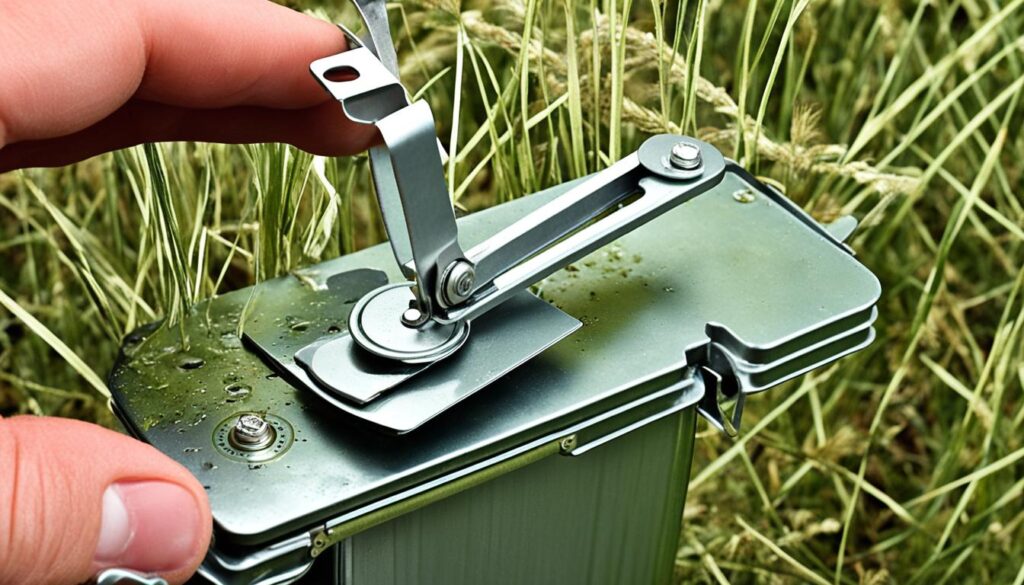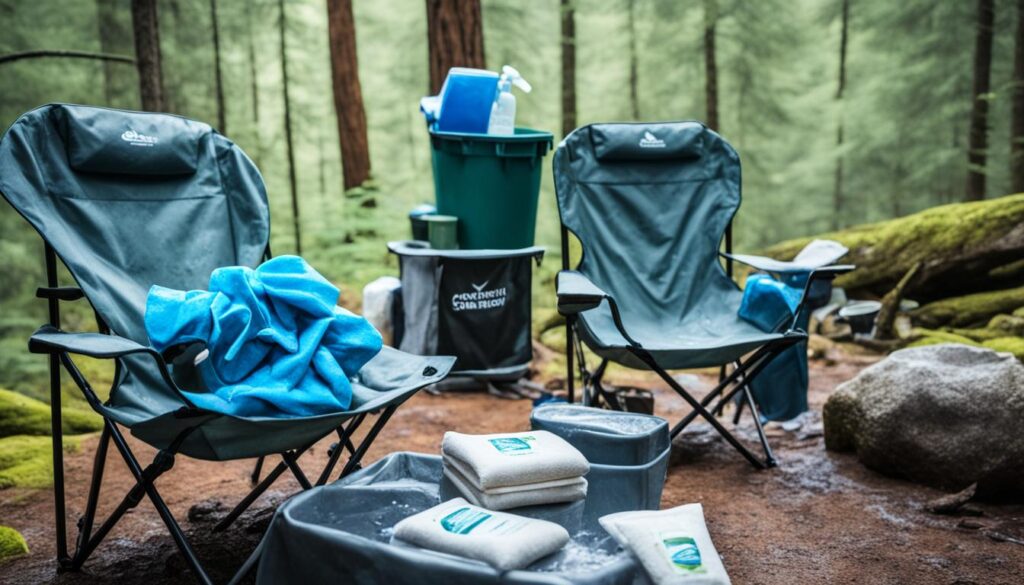When it comes to outdoor adventures, having a reliable camping can opener is a game-changer. Whether you’re preparing a quick meal or opening canned goods for a camping feast, knowing how to use a camping can opener is essential. In this comprehensive guide, I’ll walk you through step-by-step instructions, share useful tips and tricks, and provide expert advice on mastering the art of using a camping can opener. Get ready to elevate your camping culinary experience!
- Understanding how to use a camping can opener is crucial for hassle-free outdoor cooking.
- Follow a step-by-step guide to master the technique of using a camping can opener.
- Learn valuable tips and tricks for efficient and noise-free can opening during camping trips.
- Explore alternative methods to open cans quietly in case a can opener is not available.
- Enhance your camping experience by becoming an expert in using a camping can opener.
When it comes to camping can openers, not all tools are created equal. There are three main types of can openers: manual, electric, and battery-operated. While electric and battery-operated can openers may offer convenience, they often come with a trade-off – noise. For a quiet and portable can opening solution, a manual can opener is the way to go. In this section, I’ll discuss the benefits of using a manual can opener and provide tips on selecting the right one for your camping needs.
The Benefits of a Manual Can Opener
Manual can openers have been a reliable tool for opening cans for decades. They are lightweight, compact, and don’t require any power source other than your own strength. With a manual can opener, you have full control over the opening process, allowing you to adjust the speed and pressure as needed. Plus, they are quiet, making them ideal for camping trips where you want to enjoy the peacefulness of nature without the noise of an electric can opener.
How to Choose the Right Manual Can Opener
When selecting a manual can opener for camping, there are a few key factors to consider:
- Durability: Look for a manual can opener made from durable materials such as stainless steel. Camping can openers need to withstand the rigors of outdoor use.
- Portability: Opt for a compact and lightweight manual can opener that won’t take up much space in your camping gear. Folding or collapsible models are particularly convenient.
- Ergonomics: Consider a manual can opener with an ergonomic handle design for comfortable and easy operation. Look for non-slip grips to ensure a secure hold, especially when your hands are wet or slippery.
Remember, the right manual can opener for camping should be reliable, portable, and easy to use. By choosing a high-quality manual can opener, you’ll be well-equipped to open cans quietly during your outdoor adventures.
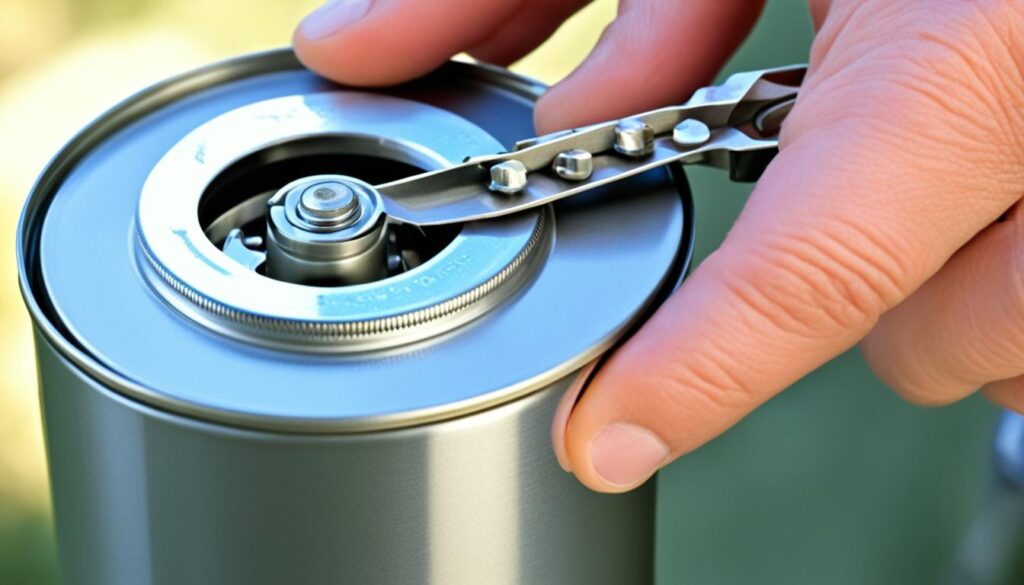
“A manual can opener is an essential tool for any camping trip. Its quiet operation allows you to enjoy the tranquility of nature while effortlessly opening cans of food. Choose a durable and portable manual can opener that suits your needs, and you’ll never go hungry in the great outdoors.”
| Can Opener Type | Pros | Cons |
|---|---|---|
| Manual Can Opener | – Quiet and portable – No reliance on batteries or power outlets – Offers full control over the opening process | – Requires manual effort – May not be suitable for individuals with limited hand strength or mobility |
| Electric Can Opener | – Convenient and effortless – Opens cans quickly | – Can be noisy – Requires batteries or access to electricity – Bulkier and less portable than manual can openers |
| Battery-Operated Can Opener | – Portable and doesn’t require manual effort – Can be quieter than electric can openers | – Requires batteries – May not be as powerful or efficient as manual or electric can openers |
Pre-Opening Preparations
Before you start opening a can, it’s important to make some pre-opening preparations to ensure a smooth and noise-free process. Taking a few extra steps beforehand can make a significant difference in the overall experience. Here are some key pre-opening preparations to consider:
- Find a stable and non-slip surface: It’s essential to have a stable surface to work on while opening a can. A cutting board or a solid countertop can serve as an ideal surface, providing stability and preventing any accidents or spills. This will also help eliminate unnecessary noise during the process.
- Check your can opener: Before you start, make sure your can opener is clean and well-maintained. A dirty or rusty can opener can make the opening process more difficult and noisy. Regularly cleaning and oiling your can opener will ensure smooth operation and reduce any squeaking or grinding noises.
- Prepare the can: Gently shake the can to settle its contents. This will help distribute any settled layers or pockets of liquid, ensuring a consistent texture throughout. Additionally, gather all the utensils you’ll need for the opening process, such as a spoon or spatula for removing the can contents.
Taking these pre-opening preparations will set the stage for a quiet and efficient can opening experience. Now that you’re well-equipped with the necessary preparations, it’s time to move on to the actual technique for quiet can opening.
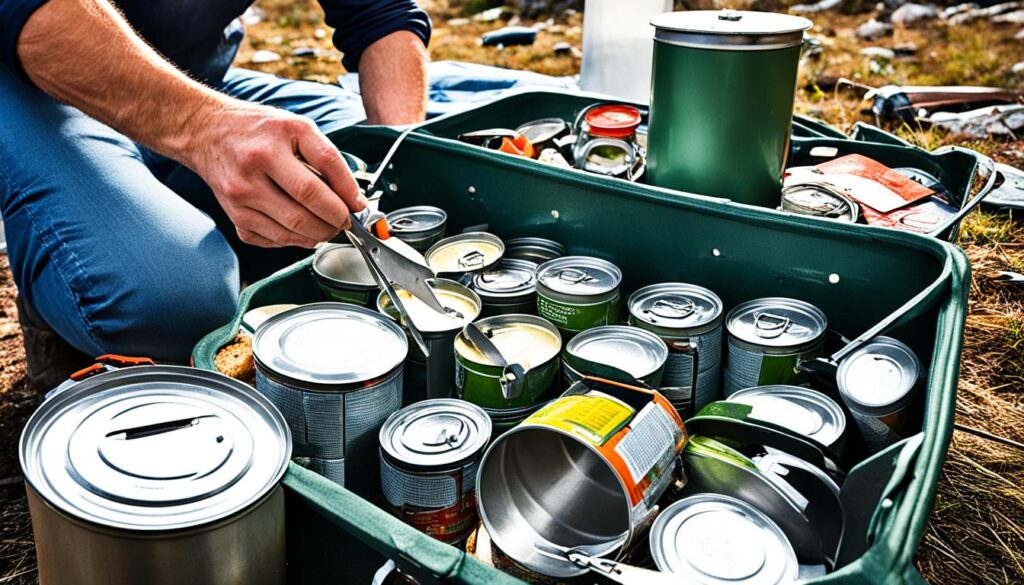
Finding a stable surface
When choosing a stable surface for opening a can, opt for a clean and level countertop or a sturdy cutting board. Avoid working on uneven or slippery surfaces to ensure stability and minimize any accidental movements or noise.
Ensuring a clean can opener
Cleaning and maintaining your can opener is essential to ensure smooth and silent operation. Regularly wash the can opener with warm soapy water, ensuring all food particles and residue are removed. Dry it thoroughly and apply a small amount of food-grade lubricant to reduce friction and prevent any squeaking or grinding sounds.
| Utensils | Purpose |
|---|---|
| Spoon or spatula | For removing can contents |
| Napkin or paper towel | For wiping off any excess liquid or food |
| Cutting board or countertop | Stable surface for can opening |
By following these pre-opening preparations, you’ll be well-prepared to open your can quietly and efficiently, ensuring a seamless outdoor dining experience. Now, let’s move on to the technique for quiet can opening in the next section.
The Technique for Quiet Can Opening
Opening a can quietly requires a specific technique and careful execution. By following these step-by-step instructions, you’ll be able to master the art of quiet can opening. Remember to position the can opener correctly, apply gentle pressure, and maintain a slow and steady turning motion for minimal noise.
- Positioning the Can Opener: Place the can opener near the edge of the lid, ensuring a secure grip. Make sure the cutting wheel is aligned with the rim of the can.
- Applying Gentle Pressure: Use a delicate touch to avoid unnecessary noise. Apply just enough pressure to pierce the lid of the can without creating excess sound.
- Slow and Steady Turning Motion: Begin turning the can opener slowly and steadily to prevent any sudden movements. Maintain a controlled pace throughout the opening process.
By following these steps, you’ll be able to open cans quietly and effortlessly. Remember to practice this technique to enhance your skills and minimize noise. Now, let’s take a look at a detailed example of the technique:
I position the can opener on the edge of the can lid, making sure it fits securely. With a gentle but firm grip, I exert slight pressure to initiate the piercing motion. As I turn the can opener slowly and steadily, I maintain a smooth rhythm, ensuring a silent opening process. The combination of a properly positioned can opener, gentle pressure, and a controlled turning motion allows me to open cans quietly and without any disturbance.
Example of the Quiet Can Opening Technique
Let’s take a closer look at the step-by-step process for opening a can quietly:
| Step | Description |
|---|---|
| Step 1 | I position the can opener near the edge of the can lid, aligning the cutting wheel with the rim. |
| Step 2 | Applying gentle pressure, I press down firmly enough to pierce the lid without making excess noise. |
| Step 3 | With a slow and steady turning motion, I rotate the can opener to create a clean, quiet opening. |
| Step 4 | Once the can is fully open, I carefully remove the lid to avoid any unnecessary noise. |
By following this technique and practicing with different cans, you’ll become adept at opening cans quietly in no time. Remember to maintain a calm and focused approach, and enjoy your noise-free camping experience!
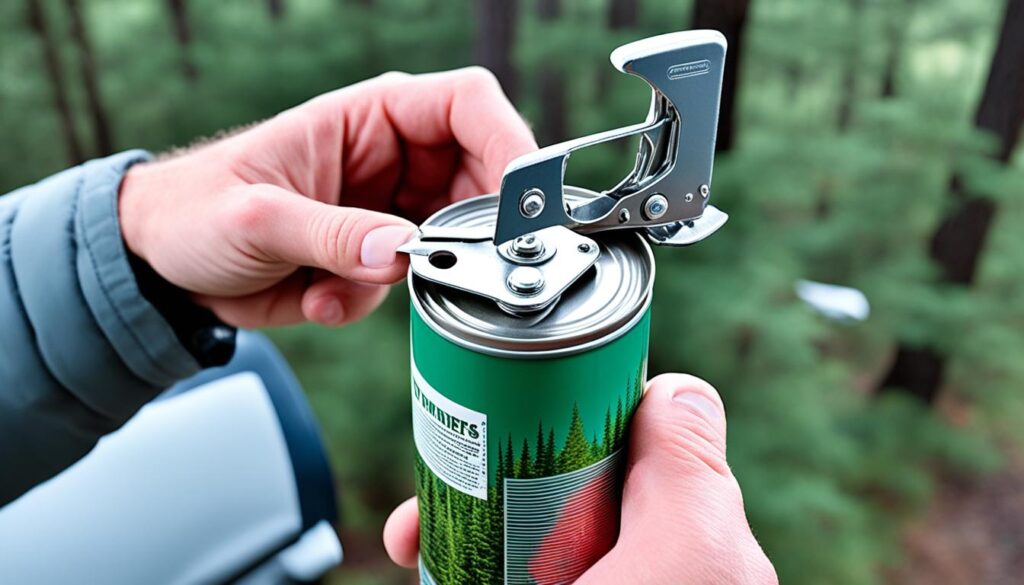
Post-Opening Tips for Minimal Noise
Opening the can quietly is just the first step. To minimize noise even further, there are post-opening tips you can follow. This section will cover techniques for draining liquid from the can without splashing, spooning out contents quietly, handling the remaining contents with care, and disposing of the can without making loud noises. By following these tips, you can ensure that your entire can-opening experience is as quiet and seamless as possible.
Draining Liquid Without Splashing
To drain the liquid from a can without splashing, use a steady hand and tilt the can slowly to pour out the liquid. Start with a small angle and gradually increase it as the liquid level decreases. This will help prevent any sudden movements that could cause splashing or spills.
Spooning Out Contents Quietly
If you need to spoon out the contents of a can, do it carefully to minimize noise. Gently insert a spoon into the can and scoop out the desired amount, making sure to scrape the sides of the can to get every last bit. Avoid banging the spoon against the edges of the can as it can create unnecessary noise.
Handling Remaining Contents with Care
After removing the desired portion from the can, handle the remaining contents with care to avoid any noise or spills. Use a spatula or another utensil to transfer the contents to another container if needed. Be mindful of any clinking or scraping sounds that could occur when transferring the contents.
Disposing of the Can Quietly
When it comes to disposing of the can, do so quietly to avoid drawing attention. Empty any remaining liquid or contents into the sink or garbage disposal. Then, crush the can by applying pressure with your hands or using a can crusher. This will help minimize noise and make the can easier to store or recycle.
| Technique | Description |
|---|---|
| Draining Liquid | Tilt the can slowly and steadily to pour out the liquid without splashing. |
| Spooning Out Contents | Gently spoon out the desired amount of contents, scraping the sides of the can to minimize noise. |
| Handling Remaining Contents | Transfer the remaining contents to another container carefully to avoid noise or spills. |
| Disposing of the Can | Empty the can completely, crush it quietly, and dispose of it properly. |
Alternative Methods for Quiet Can Opening
In situations where you find yourself without a can opener, there are alternative methods you can use to open a can quietly. While these methods may not be as efficient or easy as using a can opener, they can be effective with the right approach and care.
One alternative method is the butter knife or spoon technique. Simply insert the edge of a butter knife or the handle of a spoon into the seam of the can lid. Apply pressure and slowly work your way around the lid to loosen it. Be careful not to slip and injure yourself.
Another method is the pocketknife technique. If you have a pocketknife with a sharp blade, you can use it to puncture the lid of the can. Insert the blade at an angle and slowly cut around the lid until it’s completely detached. Remember to handle the knife with caution to prevent accidents.
The friction method is another option for quiet can opening. Rub two rough surfaces together, such as the bottom of a ceramic coffee mug or a rough rock, on the lid of the can. Apply pressure while moving the surfaces in a back and forth motion. With enough friction, you can create a hole in the lid to access the contents of the can.
FAQ
How do I choose the right can opener for camping?
There are three main types of can openers: electric, battery-operated, and manual. For quiet and portable camping can opening, it’s best to choose a manual can opener.
What should I do before I start opening a can?
Before opening a can, find a stable non-slip surface, ensure your can opener is clean and well-maintained, gently shake the can to settle its contents, and gather all the utensils you’ll need.
What is the technique for opening a can quietly?
To open a can quietly, position the can opener correctly on the lid, apply gentle pressure, and use a slow and steady turning motion.
What are some post-opening tips for minimizing noise?
To minimize noise, drain liquid from the can without splashing, spoon out contents quietly, handle the remaining contents with care, and dispose of the can without making loud noises.
Are there alternative methods for opening a can quietly?
Yes, if you don’t have a can opener, you can try using the butter knife or spoon technique, the pocketknife technique, or the friction method as alternative methods for opening a can quietly.
